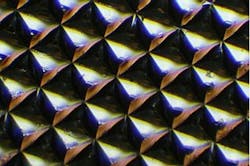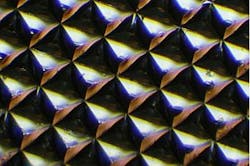Silk-based implantable optics boost tissue imaging
Tufts University School of Engineering (Medford, MA) researchers have demonstrated silk-based implantable optics that offer significant improvement in tissue imaging while simultaneously enabling photothermal therapy, administering drugs, and monitoring drug delivery. Other biomedical functions are possible as well.
Biodegradable and biocompatible, the tiny mirror-like devices dissolve harmlessly at predetermined rates and require no surgery to remove them.
"This work showcases the potential of silk to bring together form and function. In this case an implantable optical formâthe mirrorâcan go beyond imaging to serve multiple biomedical functions," says Fiorenzo Omenetto, Frank C. Doble Professor of Engineering at Tufts, who led the work.
To create the optical devices, the Tufts bioengineers poured a purified silk protein solution into molds of multiple micro-sized prism reflectors, or microprism arrays (MPAs). They pre-determined the rates at which the devices would dissolve in the body by regulating the water content of the solution during processing. The cast solution was then air dried to form solid silk films in the form of the mold. The resulting silk sheets were much like the reflective tape found on safety garments or on traffic signs.
When implanted, these MPAs reflected back photons that are ordinarily lost with reflection-based imaging technologies, thereby enhancing imaging, even in deep tissue.
The researchers tested the devices using solid and liquid phantoms, which are materials that mimic the scattering that occurs when light passes through human tissue. The tiny mirror-like devices reflected substantially stronger optical signals than implanted silk films that had not been formed as MPAs.
The Tufts researchers also demonstrated the silk mirrorsâ potential to administer therapeutic treatments. In one experiment, the researchers mixed gold nanoparticles in the silk protein solution before casting the MPAs. They then implanted the gold-silk mirror under the skin of mice. When illuminated with green laser light, the nanoparticles converted light to heat. Similar in-vitro experiments showed that the devices inhibited bacterial growth while maintaining optical performance.
The team also embedded the cancer-fighting drug doxorubicin in the MPAs. The embedded drug remained active even at high temperatures (60°C), underscoring the ability of silk to stabilize chemical and biological dopants. When exposed to enzymes in-vitro, the doxorubicin was released as the mirror gradually dissolved. The amount of reflected light decreased as the mirror degraded, allowing the researchers to accurately assess the rate of drug delivery.
"The important implication here is that using a single biofriendly, resorbable device one could image a site of interest, such as a tumor, apply therapy as needed, and then monitor the progress of the therapy," says Omenetto.
A paper on the group's technology appears in the Proceedings of the National Academy of Sciences; for more information, please visit www.pnas.org/content/109/48/19584.
-----
Follow us on Twitter, 'like' us on Facebook, and join our group on LinkedIn
Laser Focus World has gone mobile: Get all of the mobile-friendly options here.
Subscribe now to BioOptics World magazine; it's free!


